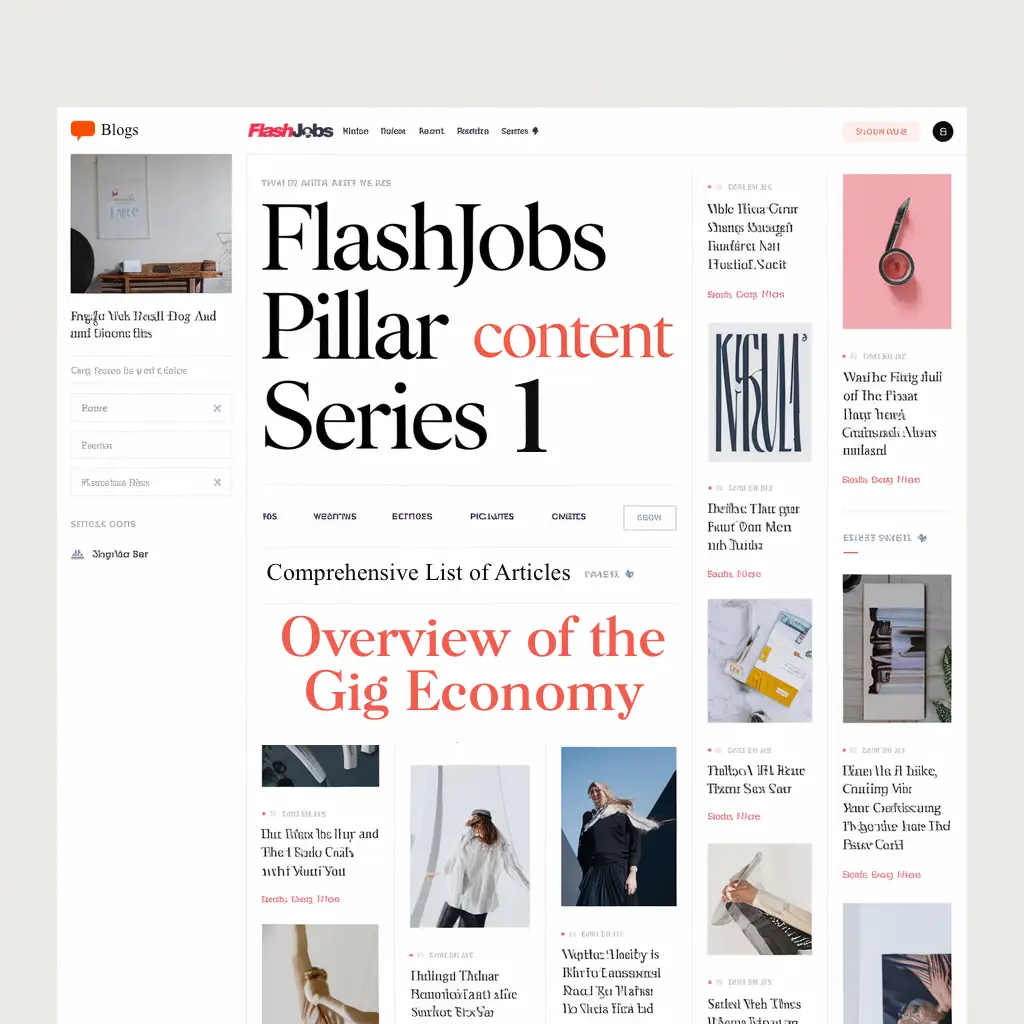7 Types of On Demand Staffs: Understanding the Modern Flexible Workforce
The gig economy has changed how people work and how companies hire. It offers many types of jobs that give workers more freedom and businesses more options. Companies can now find workers for short-term jobs or specific tasks without hiring full-time staff.
These jobs include freelance work, temp jobs, and on-demand services. Workers can pick their hours and tasks. They often use apps or websites to find work. This setup helps both workers and businesses be more flexible.
The gig economy keeps growing. It affects many fields like tech, writing, driving, and home services. As it grows, it brings new chances and issues for workers and companies.
Key Takeaways
- The gig economy offers flexible work options for both workers and businesses
- On-demand staffing includes freelancers, temps, and contract workers
- Gig work is growing and changing many industries

What Are the Main Types of On Demand Workers in the Gig Economy?
The gig economy has many types of on-demand workers. These workers fill different roles and meet various business needs. Let’s look at the main categories of gig workers.
Freelancers and Independent Contractors: The Backbone of Gig Work
Freelancers work for themselves. They offer skills to many clients. Common freelance jobs include writing, design, and coding.
These workers pick their projects. They set their own hours. Freelancers often work remotely.
Companies hire freelancers for specific tasks, which can save them money compared to hiring full-time staff. Freelancers bring fresh ideas and special skills to projects.
Temporary Workers and Temp-To-Perm Employees: Bridging Staffing Gaps
Temp workers fill short-term roles. They help during busy seasons or staff shortages. Temp jobs can last days, weeks, or months.
Temp-to-perm workers start as temps and may become full-time if they do well. This allows companies to “try before they buy” new staff.
Temp workers are common in offices, factories, and stores. They often get work through staffing agencies, which handle pay and benefits.
On-Call Workers and Day Laborers: Meeting Fluctuating Demand
On-call workers are ready when needed. They may be called for shifts on short notice, which is common in healthcare and hospitality.
Day laborers work by the day. They often do manual jobs in construction or farming. Day labor gives flexibility to both workers and employers.
On-call and day labor jobs can be less stable. But they offer quick income for workers. For businesses, these workers help meet changing needs.
Types of Contingent Workers
Contingent workers offer businesses flexible staffing options. These workers take on short-term jobs or projects without becoming full-time employees. They often have specialized skills and can be hired quickly to meet changing needs.
Independent Contractors
Independent contractors work for themselves and provide services to multiple clients. They set their own schedules and use their own tools. These workers are not employees and don’t receive benefits from their companies.
Independent contractors include:
- Web developers
- Graphic designers
- Truck drivers
- Photographers
They typically work on specific projects with clear start and end dates. Companies hire them for their expertise in a certain area, allowing businesses to complete specialized work without adding permanent staff.
Independent contractors must pay their own taxes and insurance. They have more freedom in how they work but less job security than regular employees.
Temporary Workers
Temporary workers are employees hired through staffing agencies for fixed periods of time. They work under the direct supervision of the hiring company but are technically employed by the staffing agency. These workers fill short-term needs or cover for absent employees.
Temporary workers include:
- Administrative assistants
- Warehouse workers
- Customer service representatives
- Production line workers
They typically work for weeks or months at a time. Companies hire them to handle seasonal demands, special projects, or staff shortages. This gives businesses the flexibility to adjust their workforce as needed without long-term commitments.
Temporary workers usually receive some benefits through their staffing agency, such as basic health insurance and paid time off. Their taxes are withheld by the agency. They have set schedules and use company equipment like regular employees, but their positions are not permanent.
Consultants
Consultants are experts who advise businesses. They help solve problems or improve company operations. Consultants often have years of experience in their field.
Some common types of consultants are:
- Management consultants
- IT consultants
- Marketing consultants
- Financial consultants
These workers usually come in for short periods. They might work on one big project or give ongoing advice. Consultants can work alone or as part of a consulting firm.
Companies hire consultants when they need outside knowledge. This can be cheaper than training their own staff or hiring full-time experts. Consultants bring fresh ideas and best practices from working with many different clients.
On-Call Workers
On-call workers are individuals who are available to work as needed. They don’t have regular scheduled hours but must be ready to report to work when contacted. These workers remain in a pool of available labor that employers can tap into during busy periods or emergencies.
On-call workers include:
- Substitute teachers
- Healthcare professionals
- IT support specialists
- Emergency response personnel
They typically respond to immediate staffing needs or crisis situations. Companies maintain relationships with these workers to ensure coverage during unexpected absences, peak demand periods, or emergency situations. This provides businesses with a reliable backup workforce without the cost of maintaining full-time staff for occasional needs.
On-call workers usually receive payment only for hours worked and may or may not receive benefits depending on their arrangement with the employer. They face uncertainty in their work schedules and income but often have the flexibility to accept or decline work opportunities. Some may maintain on-call status with multiple organizations to increase their chances of getting work.
Freelancers
Freelancers are self-employed workers who offer services to multiple clients. They often work in creative or technical fields and can take on short tasks or longer projects.
Common freelance jobs include:
- Writers
- Editors
- Programmers
- Virtual assistants
Freelancers find work through job boards, personal networks, or online platforms such as EzGig. They can work from home or at client sites. Some freelancers specialize in one area, while others offer a range of services.
Companies like freelancers because they can hire them as needed, which helps manage costs and workload. Freelancers also enjoy the freedom to choose their projects and set their own rates.
Temp-to-Prem Workers
Temp-to-perm workers start as temporary employees with the possibility of transitioning to permanent positions. They work under a trial arrangement that allows both the employer and worker to evaluate the fit before committing to permanent employment. These workers typically receive pay and basic benefits through a staffing agency during their temporary period.
Temp-to-perm workers include:
- Software developers
- Office managers
- Manufacturing technicians
- Sales representatives
They typically work a predetermined trial period lasting 3-6 months. Companies use this arrangement to assess the worker’s skills, cultural fit, and reliability before offering permanent employment. This allows businesses to reduce hiring risks and ensure candidates can perform the job effectively before making a long-term commitment.
Temp-to-perm workers operate under the staffing agency’s employment during their temporary period, then transition to direct employment if hired permanently. They have the opportunity to experience the work environment and job responsibilities while maintaining the option to decline permanent employment. This arrangement provides a structured path to full-time employment but requires workers to prove their value during the temporary period.
Day Laborers
Day laborers are workers hired and paid on a daily basis for manual labor or short-term work. They typically gather at designated locations or hiring sites to find work opportunities each morning. These workers do not have guaranteed employment and must secure new work assignments daily.
Day laborers include:
- Construction helpers
- Agricultural workers
- Moving assistants
- Barista workers
- Kitchen Assistants
They typically work single-day assignments with no commitment beyond the current day. Companies hire them to meet immediate labor needs or handle one-time projects. This allows businesses to quickly scale their workforce up or down based on daily requirements without any long-term obligations. FlashJobs assists small business owners in getting urgent gig workers.
Day laborers receive payment at the end of each workday and generally don’t receive any benefits. They face significant uncertainty in finding consistent work and income stability but maintain maximum flexibility to choose when and for whom they work. The arrangement is informal, with workers often paid in cash and responsible for their own tax obligations and insurance needs.
What Industries Benefit Most from the 7 Types of On Demand Staffs?
Several industries rely on flexible staffing to meet changing needs. These sectors use different types of on-demand workers to stay nimble and productive.
Technology and IT: A Hub for Freelance Consultants
Tech companies often use freelance consultants for short-term projects. These workers bring specialized skills in coding, design, or data analysis.
Many tech firms hire freelancers through staffing agencies. This helps them find talent quickly for urgent needs. Freelancers can work remotely, saving office costs.
IT consultants may work on app development or network upgrades. Their flexible schedules let companies scale teams up or down. This agility is key in the fast-paced tech world.
Hospitality and Events: Leveraging Temporary Staffing Solutions
Hotels, restaurants, and event planners use temp workers to handle busy seasons. They hire extra servers, housekeepers, or security staff as needed.
Staffing agencies help find qualified workers on short notice. This is useful for big events like weddings or conferences. Temp staff can fill in gaps during peak times.
Managers can adjust staffing levels based on bookings. This keeps labor costs in check during slow periods. It also ensures enough workers are on hand for busy times.
On-Demand Delivery and Transportation: The Rise of App-Based Gig Work
Delivery and ride-sharing apps rely on gig workers. Drivers and couriers set their own hours and use their own vehicles.
These apps connect workers directly to customers, eliminating the need for traditional staffing methods. Workers can start quickly with minimal training.
Gig work in this field offers high flexibility. Drivers can work a few hours or full-time. Companies can meet changing demand without keeping extra staff on payroll.
What Does the Future Hold for the Types of On-Demand Staffs and the Gig Economy?
The gig economy and on-demand staffing are set to change dramatically. New jobs will emerge, laws may shift, and companies will need to balance new ideas with worker rights.
Predictions for Gig Work Trends and Emerging Job Categories
Gig work is likely to grow in many fields. Tech jobs like AI trainers and virtual reality designers may become more common, and green energy gigs could rise as countries focus on climate change.
Healthcare might see more remote roles. Telemedicine assistants and at-home care providers may be in high demand.
Data shows that by 2027, over half of U.S. workers could do some gig work. This shift will affect how companies manage their workforce.
The Impact of Regulation and Policy Changes on the Gig Economy
Laws about gig work are changing. Some places are making rules to give gig workers more rights. This could mean better pay and benefits for many.
However, new laws might also make it more difficult for some gig platforms to operate. Companies may need to rethink how they hire and pay workers.
Tax rules for gig workers might also change. This could affect how much money they take home and how they report their income.
Balancing Innovation with Worker Protection in the Evolving Job Market
Companies will need to find new ways to keep gig workers happy. One option is to offer more training or opportunities to advance.
Some firms are trying out new ideas. They’re mixing full-time jobs with gig work to give workers more choices.
Tech will play a big role. New apps might help match workers to jobs faster and more fairly. But there are worries about privacy and job security.
Unions for gig workers might become more common, which could lead to better negotiations between workers and companies about fair treatment.
Conclusion
The gig economy has changed how people work and how companies hire. It gives workers more job choices and allows companies to find talent quickly when needed.
Gig work fits many types of jobs. Some examples are:
- Driving for ride-share apps
- Freelance writing or design
- Temporary office work
- On-demand home repairs
Workers like setting their own hours. They can take on different projects. But gig work doesn’t always offer steady pay or benefits.
For businesses, gig workers help during busy times. They can try out workers before hiring full-time, which reduces long-term costs.
New apps and websites make finding gig work easier. They connect workers to jobs quickly, helping both sides get what they need.
The gig economy is growing. More people and companies use it each year, and it’s now a major part of work.
As it grows, laws may change to protect gig workers. Companies might offer more perks to keep good talent. The way we think about work and jobs will keep shifting.





